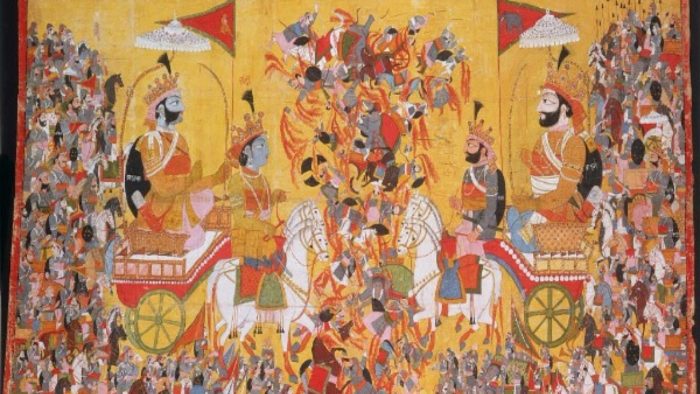Courtesy British Council
The great Indian epics the Ramayana and Mahabharata were known throughout Southeast Asia, but it was the Ramayana that most profoundly influenced Malay literary tradition. One of the oldest Malay manuscripts in a British collection is a copy of the Hikayat Seri Rama in the Bodleian Library, Oxford, which bears the ownership inscription of Archbishop Laud dated 1633. The British Library holds a manuscript of Caritra Rama, 'The story of Rama', in Romanised Malay, which was copied in Surabaya in 1812.

Caritra Rama, in Romanised Malay with many Javanese elements, copied at Surabaya in February 1812. British Library, MSS Malay D 7, f. 5r (det.).
There are however also Malay versions of the Mahabharata, some of which probably entered Malay as abbreviated prose renditions of the Old Javanese Bhratayuddha. The earliest, Hikayat Perang Pandawa Jaya, ‘The tale of the war of the victorious Pandawa’, was composed sometime between the late 14th and early 16th century, and is mentioned in the Bustan al-salatin of Nuruddin al-Raniri composed in Aceh in 1638 (Braginsky 2003: 143).
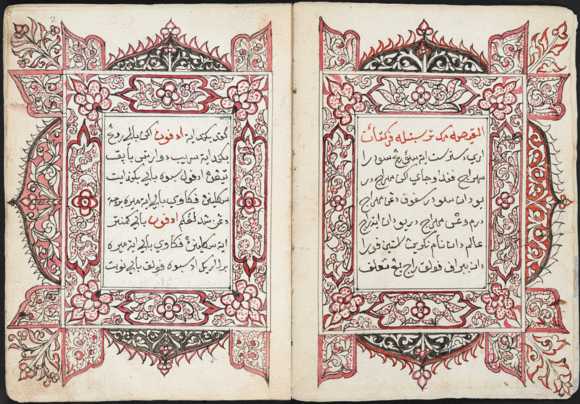
Opening pages of Hikayat Perang Pandawa Jaya, with double decorated frames in red, pink, black ink and reserved white. British Library, MSS Malay B.12, ff. 1v-2r
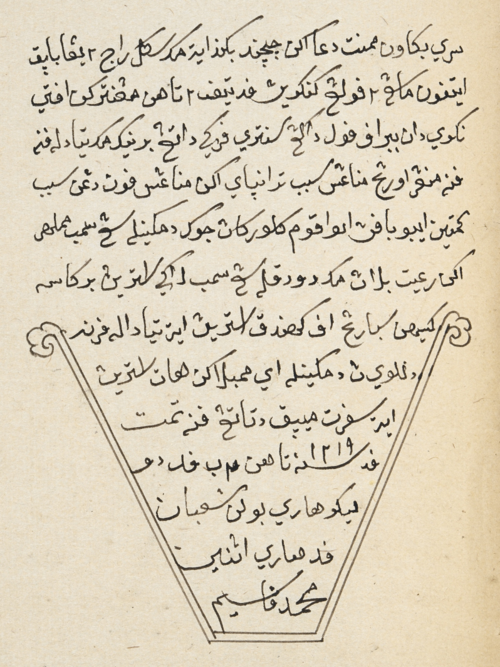
Simple finialed black ink outlines enclose the colophon of Hikayat Perang Pandawa Jaya giving the date of copying as 22 Syaaban 1219 (26 November 1804), in the year ba, on Monday, and the name of the scribe as Muhammad Kasim. British Library, MSS Malay B 12, f. 117r.
An illuminated manuscript of Hikayat Perang Pandawa Jaya (MSS Malay B 12), with brightly decorated opening frames, was copied in 1804, probably in Penang, by Muhammad Kasim. In the following year, the same scribe is known to have copied an illuminated manuscript of Hikayat Muhammad Hanafiah (MSS Malay B 6) which is also in the British Library. The epic tale revolves around the war between the Pandavas and the Kauravas, brought about by a fateful game of dice which the Kauravas win by deceit, and is presented in three parts.
The second part of the work, entitled Hikayat Pandawa Jaya, ‘The tale of the victorious Pandavas’, tells the story of the Pandavs' victory in the great war, and this part is also contained in another manuscript in the British Library, MSS Malay B 4. According to the colophon on f.90r, this manuscript was copied on 10 Rabiulawal 1220 AH (8 June 1805 AD) in the reign of Sultan Ahmad Tajuddin in Kota Setar Dar al-Aman. It was conventional practice in a number of Malay states to accompany the toponym with an honorific epithet in Arabic, such as Palembang Dar al-Salam, 'Abode of Peace', and Perak Dar al-Ridwan 'Abode of Grace', but no other Malay state is known to have had as close an association with its epithet as Kedah had with Dar al-Aman, ‘Abode of Security’, to the extent that the term Dar al-Aman alone is often used to refer to the state.
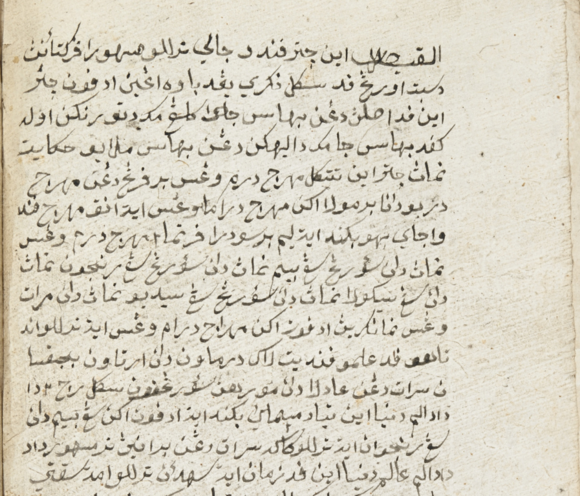 Opening lines of Hikayat Pandawa Jaya, copied in Kedah, 1805. The visible diagonal brushstrokes on the page suggest that this is Chinese paper. British Library, MSS Malay B 4, f. 2v (det.).
Opening lines of Hikayat Pandawa Jaya, copied in Kedah, 1805. The visible diagonal brushstrokes on the page suggest that this is Chinese paper. British Library, MSS Malay B 4, f. 2v (det.).
A third Malay manuscript in the British Library related to the Mahabharata is Hikayat Maharaja Boma (MSS Malay C 8), a variant of the story better known as Hikayat Sang Boma or Hikayat Sang Samba. The five Pandava brothers and their families feature in this tale (and indeed the monkey kings from the Ramayana also put in an appearance), but the main heroes are Krishna, the earthly incarnation of the god Vishnu and his father Basudewa (Sanskrit: Vasudeva), brother Baladewa and son Samba Prawira Jaya (Braginsky 2003: 152). Hikayat Sang Boma was probably composed in the 15th-16th centuries in one of the traditional centres of Javanese-Malay cultural contact. At the start of this manuscript it is said that the story was originally in 'the Indian language' (bahasa Keling), and was then translated into Javanese, and finally rendered into Malay. According to the colophon and marginal notes, the manuscript was copied by Du'ad on 24 Zulkaidah 1219 (24 February 1805).
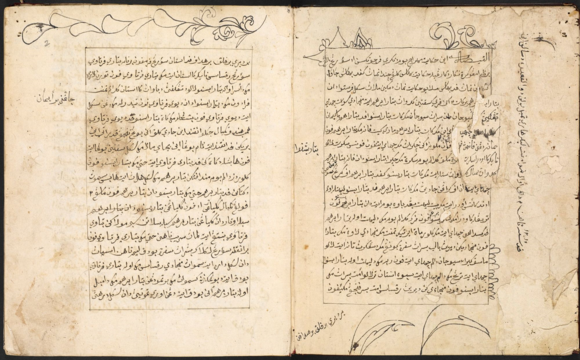 Opening pages of Hikayat Maharaja Boma, with the date of copying of 1219 (1804) inscribed vertically in the right-hand margin of the first page. British Library, MSS Malay C 8, ff. 1v-2r.
Opening pages of Hikayat Maharaja Boma, with the date of copying of 1219 (1804) inscribed vertically in the right-hand margin of the first page. British Library, MSS Malay C 8, ff. 1v-2r.
Malay tales based on the Mahabharata and Ramayana remained popular long after the coming of Islam. Vladimir Braginsky (2003: 147) suggests however that the Hindu philosophical ideas which permeate the Sanskrit epics are barely evident, and instead ‘the Malays saw primarily absorbing stories about exemplary heroes displaying military valour and courteous behaviour’, as well as relishing the exquisite descriptions of incomparable beauty. Still, the dichotomy of attempting to rationalise the older literary inheritance with Muslim beliefs and practice is a recurrent theme over the centuries. One approach taken in a number of Malay manuscripts now in the British Library collection is to place clearly visible moral warnings that the texts should be read ‘with a pinch of salt’ and should not be taken to heart. Thus the copy of Hikayat Pandawa Jaya ends with a brief unfinished syair (poem) of which the first stanza reads: 'This is the story of the victorious Pandawas / whoever reads it, don't believe a word of it / it's full of hopeless lies / of glorious imaginary worlds' (Inilah hikayat Pandawa Jaya / siapa membaca jangan percaya / bohongnya banyak tiada berdaya / dunia kayangan sangatlah mulia). Du’ad, the scribe of the manuscript of Hikayat Maharaja Boma, has added the stern admonition ‘don’t believe this’ (jangan beriman) to every folio, as can also be seen in the left-hand margin above, and at the end of the story he added a more explicit caution. The same lip-serving religious censorship device can be seen in another manuscript in the British Library copied by the same scribe (although here he spells his name Da'ut), of a Malay Panji story, Hikayat Cekel Waneng Pati (MSS Malay C 2).
 Closing verse in Hikayat Pandawa Jaya exhorting readers not to believe in the tale. British Library, MSS Malay B 4, f. 90r (det.).
Closing verse in Hikayat Pandawa Jaya exhorting readers not to believe in the tale. British Library, MSS Malay B 4, f. 90r (det.).
 The top right corner of each folio of Hikayat Maharaja Boma is labelled: 'don't believe this!' (jangan beriman). British Library, MSS Malay C 8, f. 10v (det.).
The top right corner of each folio of Hikayat Maharaja Boma is labelled: 'don't believe this!' (jangan beriman). British Library, MSS Malay C 8, f. 10v (det.).
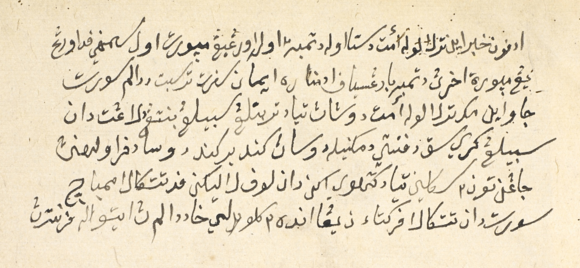
The disclaimer placed by the scribe Du'ad at the end of Hikayat Maharaja Boma: 'This writing is packed full of untruths, because it has been embellished over and over again by all the writers who have copied and recopied the text; whoever takes this Javanese story to heart is believing a pack of lies more numerous than stars in the sky or grains of sand on a beach, and his sins will pile up and multiply, so don’t be unaware or forgetful of this while reading these [undoubtedly] beautiful words, this is my warning! (Adapun khabar ini terlalulah amat dusta oleh ditambah2 oleh orang yang menyurat oleh sampai pada orang yang menyurat akhirnya ditambah barangsiapa ada menaruh iman seperti tersebut di dalam surat Jawa ini maka terlalulah amat dustanya tiada terbilang sebilang bintang di langit dan sebilang kerisik di pantai demikianlah dosanya kanda berkanda dosa diperolehannya jangan tuan2 sebagian tiada ketahui akan dan lupa lalaikan pada tatkala membaca surat dan tatkala perkataan yang indah2 kalau [berlikha?] di dalamnya itulah perintahnya). MSS Malay C 8, f. 64r
All the Malay manuscripts mentioned above how now been fully digitised and can be read on the British Library's Digitised Manuscripts site.

